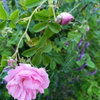There's a thread in Roses forum where Mike from MI wrote that he's in his seventies: doesn't want to spray and want to explore Kordes. Michaelg wrote this to convince Mike to stay with Austins: "I am really glad Kordes and other growers are getting serious about disease resistance, but if flowers lack fragrance and sex appeal, I'm not that interested." That was funny.
I'm posting the results of how calcium enhance Austin' sex appeal, to convince Mike further - so he will be the Guinea pig for the next batch of Austins. Michealg gave us useful info. about calcium to prolong vase life, and its anti-fungal property to prevent balling, or botrytis. Many thanks, Michaelg.
The first two pictures are Mary Magdalene and Radio Times cut at 50's dry weather, in tap water. Below is day 2 in tap water, with weak necks:
{{gwi:315764}}
Below is day 3 vase life in plain water, with Mary faded to ugly white:
{{gwi:315765}}
The next series of pics are Mary Mag. and Radio Times cut in rainy 30's weather. Once they are fully opened, I shaved calcium citrate with a scissor into the vase, 1/4 tablet per cup of water. People use Tums to prolong vase life of carnation, but I prefer calcium citrate since it's not salty like Tums, and best absorbed by the human body. Calcium Carbonate is cheaper, but absorption in the body requires acid (taken with juice).
Below is Mary Mag. at 2 days vase life and Radio Times at 3 days vase life before addition of calcium citrate:
{{gwi:315766}}
I added 1/4 tablet of calcium citrate in 1 cup water. Below is picture taken one day after calcium addition:
{{gwi:315767}}
Below is picture taken with 4 days of vase life for Mary, and 5 days of vase life for Radio Times (changed water with 1/4 calcium citrate):
{{gwi:315768}}
In the summer, Mary shatters in the vase at day 2, and I throw away Radio Times at day 3. Using calcium citrate plus cutting at cool rainy weather doubled the vase life.
My next experiment was putting Epsom salt in the vase, to test Heirloom Roses' idea that Epsom salt enhances and deepens the bloom's color. Another of Heirloom' idea is putting horse manure at the bottom of planting hole (that was a disaster for me, I had to replace the soil).
There's Heirloom idea of putting bone meal in the planting hole. A decade ago I burnt many geraniums with bone meal, plus killing a white pine. This is from Colorado State University: "CSU research has shown that Phosphorous from bone meal is only available to plants in soils that have a pH below 7.0" There's the risk of bone meal killing beneficial soil bacteria that suppress pathogenic fungi like black spots. High levels of phosphorus, from bone meal or other sources, inhibit growth of beneficial mycorrhizal Fungi, which helps roots extract phosphate from soil.
The next pictures are 2 Radio Times cut at 60's temp., soaking wet with rain. The one in the glass vase has tap water (my tap water is high in calcium). This opened easily with a delightful Damask scent. The one in the short plastic vase has 1 teaspoon of Epsom salt per 1 cup of water. At bud stage it smelled like diarrhea. Epsom salt is used as laxative, and the magnesium in Epsom salt is to relax muscle. Radio Times went limp with weak neck. I added 1 more teaspoon of Epsom salt to see if the color deepens. The scent went from diarrhea zone to sewage zone, and the leaves turned slightly yellow. Below is picture of droopy Radio Times in Epsom salt, next to the normal one in water.
{{gwi:315769}}
I rescued the limpy Radio Times by dumping out the epsom salt water, and replace with tap water plus 1/4 calcium citrate tablet. Within a few hours, Radio Times petals went from limpy to firm, its neck perked up as well. I will post pictures of both once they are fully opened, to see if the bloom color deepens.
The above showed that calcium helps with E-thing in blooms. I'm prudish so I use E-thing, which stands for erection in blooms. Question: is there any exhibitionists who used the same method? I mean people who display roses with their clothes on.













jacqueline9CA
roseseek
Related Professionals
Allentown Landscape Architects & Landscape Designers · Clark Landscape Architects & Landscape Designers · Anderson Landscape Contractors · Athens Landscape Contractors · Biloxi Landscape Contractors · East Patchogue Landscape Contractors · Fuquay-Varina Landscape Contractors · New Providence Landscape Contractors · Porterville Landscape Contractors · Santa Ana Landscape Contractors · Golden Glades Swimming Pool Builders · La Verne Swimming Pool Builders · Annapolis Siding & Exteriors · Lenoir Siding & Exteriors · Levittown Siding & Exteriorslandperson
michaelg
strawchicago z5Original Author
onederw
rosefolly
malcolm_manners
michaelg
strawchicago z5Original Author
malcolm_manners
michaelg